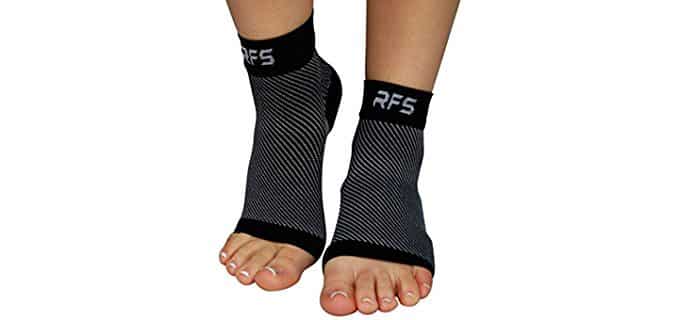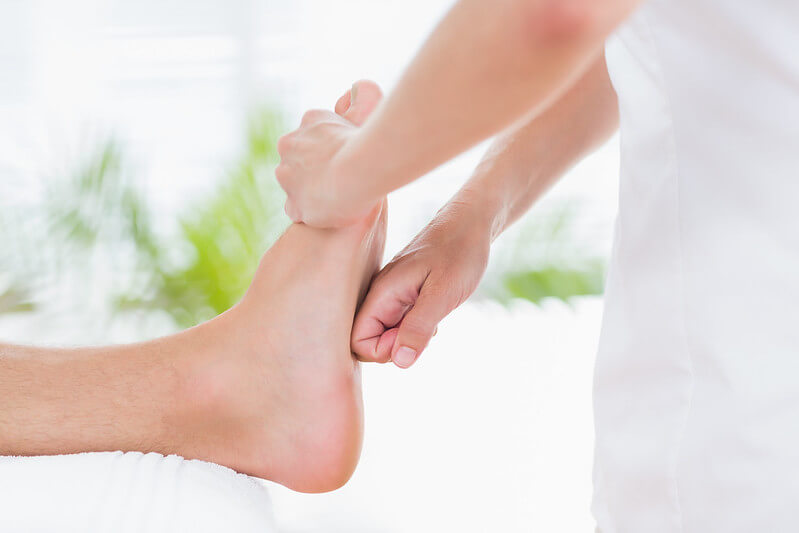Our feet have the most crucial task of carrying us through life, yet they frequently face pressure, neglect, and discomfort while doing so. Because our weight is focused on such a small surface, it is not unexpected that individuals are having more foot problems every day.
Tarsal tunnel syndrome, or TTS, is one of these issues.
If the problems and inflammations are not addressed, irreversible harm may occur. However, if you act quickly and begin wearing compression socks with arch support, many issues may be prevented.
What is Tarsal Tunnel Syndrome?
Tarsal tunnel syndrome, often known as TTS, is an inflammation of the tibial nerve. This nerve is situated in the tarsal tunnel of your foot and provides sensation and movement to the whole foot.
This nerve gets inflamed as a result of a variety of illnesses, injuries, or prolonged vigorous activity, resulting in Tarsal Tunnel Syndrome.
This is an extremely painful and uncomfortable illness that is frequently misdiagnosed, therefore it is critical to understand everything you can about it.
Causes and Symptoms of TTS
Tarsal tunnel syndrome is one of the rarest foot and leg diseases, yet it might be frequent in some people. Professionals can only establish the specific cause of TTS, but several risk factors enhance the likelihood of TTS developing in the first place.
Foot injury
Foot injuries can result in tibial nerve irritation, rupture, or pinching, all of which are causes of TTS. This is more common in athletes, but it may happen in everyday situations as well.
Prolonged vigorous activity
Prolonged actions are not just associated with sports; they may also be observed in persons with demanding professions. Standing and walking for long periods every day can create soreness and inflammation in the feet.
Flat feet or fallen arches
When it comes to maintaining a healthy posture and living a pain-free life, flat feet can be a significant disadvantage. Flat feet’ collapsed arches put a lot of tension on the surrounding tissue, making inflammations more common.
Diabetes and arthritis
Diabetes and arthritis, for example, can create a variety of degenerative problems with tissues, resulting in a great deal of pain and discomfort.
People who have this illness frequently describe it as a shooting pain that develops gradually or unexpectedly. Some people lose sensation in their feet and describe them as numb. Additionally, there may be burning and itchy feelings.
What are the treatment options?
Although TTS is one of the most unpleasant feelings in the foot, it is treatable in a variety of methods. It is preferable to seek medical attention as soon as the discomfort begins.
Because this problem only worsens over time, the ideal treatment is to prevent it or deal with it as soon as possible. If the problem is caused by flat feet or prolonged standing in uncomfortable shoes, this can be readily remedied by using arch compression socks.
Rest
Rest is one of the most effective anti-inflammatory treatments. This might involve raising your legs above your heart level for a few minutes, but you should investigate alternative options if it does not work.
When TTS is triggered by an injury or intense activity, you may need to take a lengthier break. This will allow the nerve to recover while also reducing inflammation. As the inflammation subsides, so will the pain.
Ice
Because irritation of the tibia nerve is the most common cause of foot pain, ice can be an excellent first-aid treatment. Applying cold packs to the afflicted region will reduce swelling and inflammation, alleviating pain and discomfort.
Although ice is not a permanent cure, it can be used on fatigued feet to help them for a short period of time. You can even use it in combination with your compression sleeve.
Reduce Foot Pressure
People who stand for long periods of time or engage in other strenuous activities must consider the pressure on their feet. This is one of several causes of TTS and is readily remedied by lowering the pressure.
This may be accomplished by wearing more comfortable shoes or by adding some pads or cushions to improve fit and minimize pressure.
Orthopedic Devices
If the TTS problem reoccurs frequently and the pain becomes chronic, you should consider having custom-made shoes and insoles created.
These modifications can greatly enhance your foot's position in the shoe and perhaps solve the problem. Orthopedic devices that provide ankle support are sometimes the most effective non-invasive option.
Compression
Compression of the foot and leg is reported to be highly beneficial in the treatment of TTS. There is a reduced likelihood of tibial nerve inflammation when you wear arch support compression socks, for example, since circulation is enhanced and your arch receives more support.
Because of the support and compression, there is no additional strain on that portion of the leg, making your feet feel lighter and more comfortable.
Physical Therapy
If nothing else works, seek physical therapy before undergoing surgery or injections. Although certain medicines can help with pain management, physical therapy provides long-term answers.
This might involve ultrasound therapy, exercises, and stretching, all of which help relieve nerve strain and strengthen your feet.
How to self-treat Tarsal Tunnel Syndrome (TTS) with compression socks?
Arch compression socks might be one of the greatest treatments for TTS, and there are several reasons for this. Because the tissue or nerve is inflamed, the best remedy is to prevent direct pressure on the tarsal tunnel and instead wear moisture-wicking socks that support your arch and provide pressure to the bottom portion of your foot.
This will help to support the arch, relieve pressure on the nerve, and improve blood flow and circulation. Once the pressure is removed and oxidized blood is rushing to the inflamed region, the area will have a greater chance of healing.
Supportive socks will help your feet feel lighter if you are suffering from plantar fasciitis while also giving your body a chance to recuperate. Because we do not have much time in our hectic life to rest, the next best thing is to think about what you can do to aid your feet every day.
Exercises For TTS
While your feet are hurting and swollen, exercising may be the last thing on your mind, but it is one of the best things you can do to avoid TTS and treat it when it happens.
Consider our list of simple workouts and stretches to strengthen muscular support in your feet and assure a pain-free experience in the future once your feet have recovered.
Balance exercises
This may seem simple, but a loss of balance can create significant difficulties not just with your feet, but also with your back and posture. By learning how to execute simple balance exercises, you can strengthen the muscles in your feet and avoid future injuries.
Stretching
Simple stretching exercises might help with pain relief in the foot and plantar fasciitis pain. Even a small rotation of your feet in the other way might alleviate discomfort. Because TTS is related to pressure and tightness, stretching will give instant relief.
Here are some examples of stretching exercises:
Plantar fascia stretch
Stretch this area of your foot with your hands or a towel. Simply grasp your big toe and the ball of your foot and pull it towards you. When you feel the pressure, come to a complete halt and maintain the posture for 30 seconds before releasing.
If you perform this easy exercise daily, you will notice a significant reduction in pain and discomfort. In addition, always wear compression socks.
Gastrocnemius stretch
This stretch is done in a standing position, with your hands on the wall. Imagine doing push-ups and put one leg closer to the wall while stretching the other. Rotate the legs and feel the tightening along the calf and the entire leg. Repeat daily for optimum results.
Roll Out the Arch
Consider the rolling approach if the inflammation and soreness are caused by the falling arch of your foot and increased pressure. When you roll round objects beneath your foot, such as balls, cans, or a specific massager, you will feel immediate relief from the pressure.
Rolling can be done practically anywhere, and the workplace might be a nice location to do it for a few minutes. If that is not feasible, make it a point to rest and stretch your feet every day before going to bed.
Also, if you have socks for plantar fasciitis make sure to wear them daily.
This ensures that you are doing all possible to avoid the problem from occurring in the first place, as well as making the discomfort more manageable if it does happen with graduated compression.
Conclusion
Healthy feet are sometimes taken for granted, and it is only when pain and discomfort occur that we realize that something may be done. The greatest answer for everyone is to avoid potential difficulties. If you have flat feet or suffer from chronic discomfort, you should think about all of your options, including arch support socks.
If you want to make it even simpler to have healthy feet, you should relax and exercise daily.




Leave a comment
This site is protected by hCaptcha and the hCaptcha Privacy Policy and Terms of Service apply.